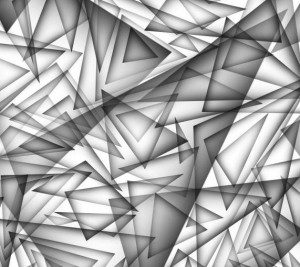The point of triangles

In the geometric world, triangles represents the interface between choice and creative forces. We make thousands of choices every day so it’s tempting to imagine what life could be like if we made different choices. Not just the big choices, like where to work or who to marry, but the small ones – after all there’s no such thing as a small choice. The decision to catch a later train could set in motion a sequence of events that could dramatically alter the whole course of life. Knowing this, (even at a subconscious level) it’s no wonder we struggle with decisions and do our best to abdicate any responsibility for them. How can we possibly configure all the permutations and work out the correct option?
We can’t.
Really brilliant choices often happen to us when we ‘get out of our own way’ and let the universe get on with its evolutionary journey. We don’t trust this process. We’re scared that what works for the whole may not be in our individual best interests. This leads to a bit of a Mexican stand off between the ‘I’ and the ‘We’.
The next chapter in evolution sees an increase in our intelligence (and not before time!). This would allow us to live in the heart of the paradox that we function simultaneously as an individual and as part of the whole. Both are true. Science is teasing us with this riddle. We know that light is both a wave and a particle. We know that electrons can exist in several places at the same time.
As Niels Bohr said ‘If quantum mechanics hasn’t profoundly shocked you, you haven’t understood it yet’.
Sadly, in the middle of these exciting times, we are hanging on firmly to our Neanderthal heritage. We don’t care about the whole, we just want to survive as an individual and kill anything that surprises us.
Back to our current lop sided triangles. We live in a world of duality represented by the two points on either side of a straight line: left/right, light/dark, angry/passive, risky/safe – you get the picture. Between these two points, there are numerous shades of colour, variations of emotion, degrees of fear. To move forward, we have to make a choice somewhere between the two and put a stake in the ground (third point of the triangle)…Simples.
So why have we collectively made so many bad choices? Because our wiring has a couple of glitches that need ironing out.
1. Default program of laziness – we keep choosing the colour/strategy/emotion that we’re familiar with. No new pattern emerges.
2. Default program of attack – instead of choosing from inspiration (what we would love) we look at the things we hate and choose the opposite. We choose red because we hate beige, we choose rational because we hate emotional. These are toxic rather than inspired choices so often have a negative effect. It’s a bit like the space invaders game. We keep shooting down the enemy but they multiply and soon we’re surrounded by needy, beige people.
Time to start thinking and communicating more clearly. We say ‘this works for me’ when we don’t want to accept the reality that it isn’t working for anybody else. We say ‘that’s bad idea’ when we really mean ‘I don’t like it’ or ‘it makes me uncomfortable’.
If we learn to co-exist with things instead of demonising them, we might find we’ve got more discernment. If we were able to hold the dynamic tension between two opposing forces without disassociating or getting angry we could definitely make better decisions. Instead of closing our eyes and chucking a stake in the ground, we could pause, think for a second and actually decide where to place it.

2 Comments
Three points on Triangles:
1 – I’ve been working with 20 teenagers on curriculum innovation at a secondary school recently – we developed a board game currently being rejigged for on line play. Triangles play a big part: Trinity. We located the DNA of information, and therefore of the whole curriculum, within four basic archetypal concepts: mandala, unity, duality, trinity and quaternity.
2 – I like the way you frame the default glitches here, but the poet in me wants to see a third, perhaps to do with avoiding responsibility (which you also hint at) due to feeling of disempowerment? (can this be addressed by enhanced critical consciousness through dialogue?)
3 – Is unity the key to overcoming subject-object duality and moving it onwards and upwards to trinity?
David. x
Hi David, your work on curriculum innovation sounds really interesting and I’d love to hear more about it. The avoiding responsibility thing is a big part so I put this into the ‘square’ category of geometry with four components – four archetypes. The child who wants to abdicate responsibility and not grow up to become empowered. The victim who has no boundaries so becomes fused to the identity of the a disempowered person. The prostitute who feels the need to negotiate their power for safety, and the Saboteur who is actually afraid of empowerment so creates blocks, problems, cynicism, negative self talk etc to ensure empowerment doesn’t happen! Dialogue through the dynamics of these four rugged players present in each of us is the way through the square. Unity or integration of the two opposing points on the straight line gives us the power to move onwards and upwards to the trinity. Good to hear from you! x